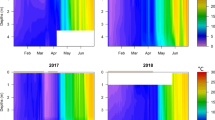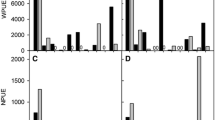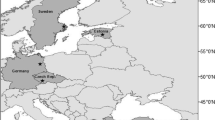Abstract
Winter fish kills can be intense under ice in shallow lakes, and have cascading effects on the food web and ultimately on lake water clarity. In maritime Western Europe, winters are usually mild, but occasional colder periods may also have strong effects on lake fish communities. Global warming may have disproportionate effects by delaying freezing and shortening the period of ice coverage. We studied differences in zooplankton (cladocerans, copepods, and rotifers): phytoplankton biomass, zooplankton community structure, and individual body size among 37 Danish lakes of various depths, chemical characteristics, and trophy, by comparing four winters of different severity (mean winter temperatures ranging from −1.19°C in 1996 to +2.9°C in 1995). We found that crustacean mean body sizes were significantly larger in the summer following a severely cold winter. The zooplankton communities in the summer after a cold winter had a significantly larger proportion of larger-bodied species and taxa. Phytoplankton biomass, expressed as chlorophyll-a (chl-a), was lower and zooplankton herbivory (chl-a:TP index), higher, in the summer after the severely cold winter of 1995/1996. All these effects were stronger in shallow lakes than in deep lakes. Changes in zooplankton during summer 1996, compared with other years, were likely caused by fish kills under ice during the preceding severe winter of 1995–1996. Fish kills due to under ice oxygen depletion would be expected to occur earlier and be more complete in the shorter water columns of shallow lakes. With climate change, severe winters are predicted to become less frequent and the winters to be milder and shorter. In general, this is likely to lead to higher winter survival of fish, lower zooplankton grazing of phytoplankton the following summer and more turbid waters, particularly in shallow eutrophic lakes.






Similar content being viewed by others
References
Adrian, R. & R. Deneke, 1996. Possible impact of mild winters on zooplankton succession in eutrophic lakes of the Atlantic European area. Freshwater Biology 36: 757–770.
Adrian, R., N. Walz, T. Hintze, S. Hoeg & R. Rusche, 1999. Effects of ice duration on plankton succession during spring in a shallow polymictic lake. Freshwater Biology 41: 621–632.
Atkinson, D., 1994. Temperature and organism size – a biological law for ectotherms. Advances in Ecological Research 25: 1–58.
Benndorf, J., J. Kranich, T. Mehner & A. Wagner, 2001. Temperature impact on the midsummer decline of Daphnia galeata: an analysis of long-term data from the biomanipulated Bautzen Reservoir (Germany). Freshwater Biology 46: 199–211.
Blenckner, T. & H. Hillebrand, 2002. North Atlantic Oscillation signatures in aquatic and terrestrial ecosystems – a meta-analysis. Global Change Biology 8: 203–212.
Bottrell, H. H., A. Duncan, Z. M. Gliwicz, E. Grygierek, A. Herzig, A. Hillbricht-Ilkowska, H. Kurasawa, P. Larsson & T. Weglenska, 1976. A review of some problems in zooplankton production studies. Norwegian Journal of Zoology 24: 419–456.
Brooks, J. L. & S. I. Dodson, 1965. Predation, body size, and composition of plankton. Science 150: 28–35.
Feuchtmayr, H., R. Moran, K. Hatton, L. Connor, T. Heyes, B. Moss, I. Harvey & D. Atkinson, 2009. Global warming and eutrophication: effects on water chemistry and autotrophic communities in experimental hypertrophic shallow lake mesocosms. Journal of Applied Ecology 46: 713–723.
George, D. G. & G. P. Harris, 1985. The effect of climate on long-term changes in the crustacean zooplankton biomass of Lake Windermere, UK. Nature 316: 536–539.
Gerten, D. & R. Adrian, 2000. Climate-driven changes in spring plankton dynamics and the sensitivity of shallow polymictic lakes to the North Atlantic Oscillation. Limnology and Oceanography 45: 1058–1066.
Gerten, D. & R. Adrian, 2002. Species-specific changes in the phenology and peak abundance of freshwater copepods in response to warm summers. Freshwater Biology 47: 2163–2173.
Gillooly, J. F. & S. I. Dodson, 2000. Latitudinal patterns in the size distribution and seasonal dynamics of new world, freshwater cladocerans. Limnology and Oceanography 45: 22–30.
Gliwicz, M. Z. & J. Pijanowska, 1989. The role of predation in zooplankton succession. In Sommer, U. (ed.), Plankton Ecology: Succession in Plankton Communities. Springer, Berlin.
Gyllström, M., et al., 2005. The role of climate in shaping zooplankton communities of shallow lakes. Limnology and Oceanography 50: 2008–2021.
Hansen, A., E. Jeppesen, S. Bosselmann & P. Andersen, 1992. Zooplankton i søer – metoder og artsliste. Prøvetagning, bearbejdning og rapportering ved undersøgelser af zooplankton i søer. Miljøproject No. 205. Miljøstyrelsen. 116s [Zooplankton in lakes – methods and species list. Sampling, processing and reporting for zooplankton investigations in lakes].
Hansson, L.-A., A. Nicolle, J. Brodersen, P. Romare, C. Skov, P. A. Nilsson & C. Brönmark, 2007. Consequences of fish predation, migration, and juvenile ontogeny on zooplankton spring dynamics. Limnology and Oceanography 52: 696–706.
Hurst, T. P., 2007. Causes and consequences of winter mortality in fishes. Journal of Fish Biology 71: 315–345.
IPCC, 2007. Impacts, Adaptation and Vulnerability. Contribution of Working Group II to the Fourth Assessment Report of the Intergovernmental Panel on Climate Change, Cambridge.
Jackson, L., T. Lauridsen, M. Søndergaard & E. Jeppesen, 2007. A comparison of shallow Danish and Canadian lakes and implications of climate change. Freshwater Biology 52: 1782–1792.
Jeppesen, E., M. Søndergaard, E. Mortensen, P. Kristensen, B. Riemann, H. J. Jensen, J. P. Müller, O. Sortkjær, J. P. Jensen, K. Christoffersen, S. Bosselmann & E. Dall, 1990. Fish manipulation as a lake restoration tool in shallow, eutrophic, temperate lakes. 1. Cross-analysis of three Danish case-studies. Hydrobiologia 200(201): 205–218.
Jeppesen, E., J. P. Jensen, M. Søndergaard, T. Lauridsen & F. Landkildehus, 2000. Trophic structure, species richness and biodiversity in Danish lakes: changes along a phosphorus gradient. Freshwater Biology 45: 201–218.
Jeppesen, E., J. P. Jensen, C. Jensen, B. Faafeng, P. Brettum, D. Hessen, M. Søndergaard, T. Lauridsen & K. Christoffersen, 2003. The impact of nutrient state and lake depth on top-down control in the pelagic zone of lakes: a study of 466 lakes from the temperate zone to the arctic. Ecosystems 6(4): 313–325.
Jeppesen, E., J. P. Jensen, M. Søndergaard, M. Fenger-Grøn, M. E. Bramm, K. Sandby, P. H. Møller & H. U. Rasmussen, 2004. Impact of fish predation on cladoceran body weight distribution and zooplankton grazing in lakes during winter. Freshwater Biology 49(4): 432–447.
Jeppesen, E., M. Søndergaard, J. P. Jensen, K. Havens, O. Anneville, L. Carvalho, M. F. Coveney, R. Deneke, M. Dokulil, B. Foy, D. Gerdeaux, S. E. Hampton, K. Kangur, J. Köhler, S. Körner, E. Lammens, T. L. Lauridsen, M. Manca, R. Miracle, B. Moss, P. Nõges, G. Persson, G. Phillips, R. Portielje, S. Romo, C. L. Schelske, D. Straile, I. Tatrai, E. Willén & M. Winder, 2005. Lakes’ response to reduced nutrient loading – an analysis of contemporary long term data from 35 case studies. Freshwater Biology 50: 1747–1771.
Jeppesen, E., B. Kronvang, M. Meerhoff, M. Sondergaard, K. M. Hansen, H. E. Andersen, T. L. Lauridsen, L. Liboriussen, M. Beklioglu, A. Ozen & J. E. Olesen, 2009. Climate change effects on runoff, catchment phosphorus loading and lake ecological state, and potential adaptations. Journal of Environmental Quality 38: 1930–1941.
Jespersen, A.-M. & K. Christoffersen, 1987. Measurements of chlorophyll a from phytoplankton using ethanol as extraction solvent. Archiv für Hydrobiologie 109: 445–454.
Kronvang, B., G. Aertebjerg, R. Grant, P. Kristensen, M. Hovmand & J. Kirkegaard, 1993. Nationwide monitoring of nutrients and their ecological effects – State of the Danish aquatic environment. Ambio 22(4): 176–187.
Link, J., J. H. Selgeby & R. E. Keen, 2004. Changes in the Lake Superior Crustacean zooplankton community. Journal of Great Lakes Research 30: 327–339.
Luecke, C., M. J. Vanni, J. J. Magnuson, J. K. Kitchell & P. T. Jacobson, 1990. Seasonal regulation of Daphnia populations by planktivorous fish – implications for the spring clear-water phase. Limnology and Oceanography 35: 1718–1733.
Mazumder, A., D. J. McQueen, W. D. Taylor, D. R. S. Lean & M. D. Dickman, 1990. Micro- and mesozooplankton grazing on natural pico- and nanoplankton in contrasting plankton communities produced by planktivore manipulation and fertilisation. Archiv für Hydrobiologie 118: 257–282.
McCauley, E., 1984. The estimation of the abundance and biomass of zooplankton in samples. In Downing, J. A. & F. H. Rigler (eds), A Manual on Methods for the Assessment of Secondary Productivity in Fresh Waters. Blackwell, Oxford.
McKee, D., D. Atkinson, S. Collings, J. Eaton, I. Harvey, T. Heyes, K. Hatton, D. Wilson & B. Moss, 2002. Macro-zooplankter responses to simulated climate warming in experimental freshwater microcosms. Freshwater Biology 47: 1557–1570.
McKee, D., D. Atkinson, S. E. Collings, J. W. Eaton, A. B. Gill, I. Harvey, K. Hatton, T. Heyes, D. Wilson & B. Moss, 2003. Response of freshwater microcosm communities to nutrients, fish, and elevated temperature during winter and summer. Limnology and Oceanography 48: 707–722.
McQueen, D. J., J. R. Post & E. L. Mills, 1986. Trophic relationships in freshwater pelagic ecosystems. Canadian Journal of Fisheries and Aquatic Sciences 43: 1571–1581.
Meding, M. E. & L. J. Jackson, 2003. Biotic, chemical, and morphometric factors contributing to winter anoxia in prairie lakes. Limnology and Oceanography 48: 1633–1642.
Meerhoff, M., J. M. Clemente, F. T. de Mello, C. Iglesias, A. R. Pedersen & E. Jeppesen, 2007. Can warm climate-related structure of littoral predator assemblies weaken the clear water state in shallow lakes? Global Change Biology 13: 1–10.
Mehner, T., 2000. Influence of spring warming on the predation rate of underyearling fish on Daphnia – a deterministic simulation approach. Freshwater Biology 45: 253–263.
Mooij, W. M., 1996. Variation in abundance and survival of fish larvae in shallow eutrophic Lake Tjeukemeer. Environmental Biology of Fishes 46: 265–279.
Mooij, W. M., et al., 2005. The impact of climate change on lakes in the Netherlands: a review. Aquatic Ecology 39: 381–400.
Moran, R., I. Harvey, B. Moss, H. Feuchtmayr, K. Hatton, T. Heyes, & D. Atkinson, 2009. Influence of simulated climate change and eutrophication on three-spined stickleback populations: a large scale mesocosm experiment. Freshwater Biology. doi:10.1111/j.1365-2427.2009.02276.x.
Mortensen, E., H. J. Jensen, J. P. Müller & M. Timmermann, 1990. Fiskeundersøgelsesprogram, fiskeredskaber of metoder. Danmarks Miljøundersøgelser, teknisk anvisning nr. 3 (in Danish).
Moss, B., D. McKee, D. Atkinson, S. E. Collings, J. W. Eaton, A. B. Gill, I. Harvey, K. Hatton, T. Heyes & D. Wilson, 2003. How important is climate? Effects of warming, nutrient addition and fish on phytoplankton in shallow lake microcosms. Journal of Applied Ecology 40: 782–792.
Moss, B., D. Stephen, D. Balayla, E. Bécares, S. E. Collings, C. Fernández-Aláez, M. Fernández-Aláez, C. Ferriol, P. García, J. Gomà, M. Gyllström, L.-A. Hansson, J. Hietala, T. Kairesalo, M. R. Miracle, S. Romo, J. Rueda, V. Russell, A. Stahl-Delbanco, M. Svensson, K. Vakkilainen, M. Valentín, W. J. van de Bund, E. van Donk, E. Vicente & M. J. Villena, 2004. Continental-scale patterns of nutrient and fish effects on shallow lakes: synthesis of a pan-European mesocosm experiment. Freshwater Biology 49: 1633–1649.
Nyberg, P., E. Bergstrand, E. Degerman & O. Enderlein, 2001. Recruitment of pelagic fish in an unstable climate: studies in Sweden’s four largest lakes. Ambio 30: 559–564.
Räisänen, J., U. Hansson, A. Ullerstig, R. Döscher, L. Graham, C. Jones, H. Meier, P. Samuelsson & U. Willén, 2004. European climate in the late twenty-first century: regional simulations with two driving global models and two forcing scenarios. Climate Dynamics 22: 13–31.
Rettig, J. E., 2003. Zooplankton responses to predation by larval bluegill: an enclosure experiment. Freshwater Biology 48: 636–648.
Ruttner-Kolisko, A., 1977. Suggestions of biomass calculation of plankton rotifers. Archiv für Hydrobiologie Beiheft/Ergebnisse der Limnologie 8: 71–76.
Sillmann, J. & E. Roeckner, 2008. Indices for extreme events in projections of anthropogenic climate change. Climatic Change 86(1–2): 83–104.
Straile, D., 2000. Meteorological forcing of plankton dynamics in a large and deep continental European lake. Oecologia 122: 44–50.
Tirok, K. & U. Gaedke, 2006. Spring weather determines the relative importance of ciliates, rotifers and crustaceans for the initiation of the clear-water phase in a large, deep lake. Journal of Plankton Research 28: 361–373.
Whiteside, M. C., 1988. 0+ fish as major factors affecting abundance pattern of littoral zooplankton. Verhandlungen Internationale Vereinigung für Theoretische und Angewandte Limnologie 21: 1710–1714.
Winder, M. & D. E. Schindler, 2004. Climatic effects on the phenology of lake processes. Global Change Biology 10: 1844–1856.
Acknowledgments
We would like to thank all staff from the National Environment Research Institute (NERI) and the Danish Counties, who collected the data from the set of lakes used in this article. Many thanks are due to a number of colleagues at NERI for interesting discussions and help: Thomas B. Kristensen, Sandra Brucet, Marc Ventura, Carolina Trochine, Liselotte Sander Johansson, Lone Libourissen, Lissa Skov Hansen, Ulla Kvist Pedersen, and Ole Sortkjær. Thanks are due to Søren Larsen for advice on SAS programming for size structure analyses and to Anne Mette Poulsen for revising the English. The analyses were funded by the European Commission project ENDURE (Marie Curie Individual fellowship MEIF-CT-2006-038366).
Author information
Authors and Affiliations
Corresponding author
Additional information
Guest editors: M. Meerhoff, M. Beklioglu, R. Burks, F. García-Rodríguez, N. Mazzeo & B. Moss / Structure and Function of World Shallow Lakes: Proceedings from the 6th Shallow Lakes Congress, held in Punta del Este, Uruguay, 23–28 November, 2008
Rights and permissions
About this article
Cite this article
Balayla, D., Lauridsen, T.L., Søndergaard, M. et al. Larger zooplankton in Danish lakes after cold winters: are winter fish kills of importance?. Hydrobiologia 646, 159–172 (2010). https://doi.org/10.1007/s10750-010-0164-4
Published:
Issue Date:
DOI: https://doi.org/10.1007/s10750-010-0164-4




